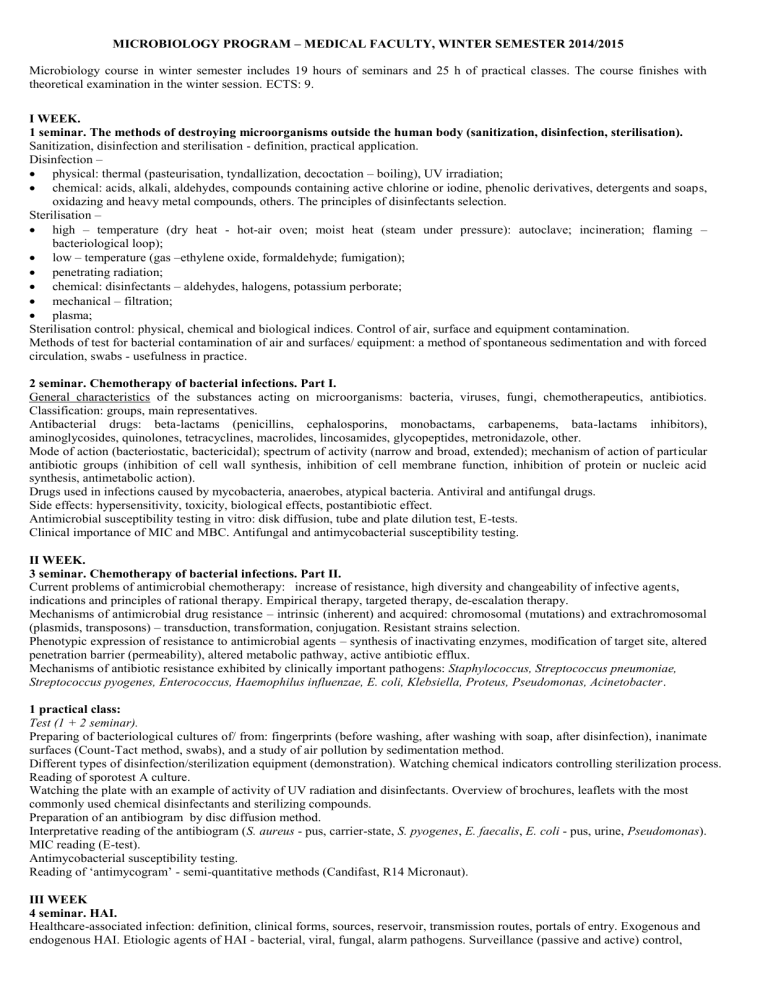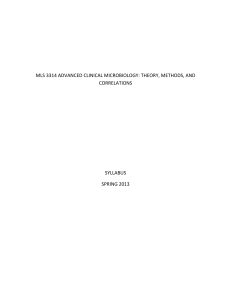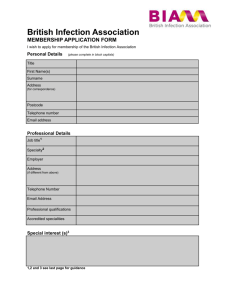microbiology program – medical facylty, winter semester 2014/2015

MICROBIOLOGY PROGRAM – MEDICAL FACULTY, WINTER SEMESTER 2014/2015
Microbiology course in winter semester includes 19 hours of seminars and 25 h of practical classes. The course finishes with theoretical examination in the winter session. ECTS: 9.
I WEEK.
1 seminar. The methods of destroying microorganisms outside the human body (sanitization, disinfection, sterilisation).
Sanitization, disinfection and sterilisation - definition, practical application.
Disinfection –
physical: thermal (pasteurisation, tyndallization, decoctation – boiling), UV irradiation;
chemical: acids, alkali, aldehydes, compounds containing active chlorine or iodine, phenolic derivatives, detergents and soaps, oxidazing and heavy metal compounds, others. The principles of disinfectants selection.
Sterilisation –
high – temperature (dry heat - hot-air oven; moist heat (steam under pressure): autoclave; incineration; flaming – bacteriological loop);
low – temperature (gas –ethylene oxide, formaldehyde; fumigation);
penetrating radiation;
chemical: disinfectants – aldehydes, halogens, potassium perborate;
mechanical – filtration;
plasma;
Sterilisation control: physical, chemical and biological indices. Control of air, surface and equipment contamination.
Methods of test for bacterial contamination of air and surfaces/ equipment: a method of spontaneous sedimentation and with forced circulation, swabs - usefulness in practice.
2 seminar. Chemotherapy of bacterial infections. Part I.
General characteristics of the substances acting on microorganisms: bacteria, viruses, fungi, chemotherapeutics, antibiotics.
Classification: groups, main representatives.
Antibacterial drugs: beta-lactams (penicillins, cephalosporins, monobactams, carbapenems, bata-lactams inhibitors), aminoglycosides, quinolones, tetracyclines, macrolides, lincosamides, glycopeptides, metronidazole, other.
Mode of action (bacteriostatic, bactericidal); spectrum of activity (narrow and broad, extended); mechanism of action of particular antibiotic groups (inhibition of cell wall synthesis, inhibition of cell membrane function, inhibition of protein or nucleic acid synthesis, antimetabolic action).
Drugs used in infections caused by mycobacteria, anaerobes, atypical bacteria. Antiviral and antifungal drugs.
Side effects: hypersensitivity, toxicity, biological effects, postantibiotic effect.
Antimicrobial susceptibility testing in vitro: disk diffusion, tube and plate dilution test, E-tests.
Clinical importance of MIC and MBC. Antifungal and antimycobacterial susceptibility testing.
II WEEK.
3 seminar. Chemotherapy of bacterial infections. Part II.
Current problems of antimicrobial chemotherapy: increase of resistance, high diversity and changeability of infective agents, indications and principles of rational therapy. Empirical therapy, targeted therapy, de-escalation therapy.
Mechanisms of antimicrobial drug resistance – intrinsic (inherent) and acquired: chromosomal (mutations) and extrachromosomal
(plasmids, transposons) – transduction, transformation, conjugation. Resistant strains selection.
Phenotypic expression of resistance to antimicrobial agents – synthesis of inactivating enzymes, modification of target site, altered penetration barrier (permeability), altered metabolic pathway, active antibiotic efflux.
Mechanisms of antibiotic resistance exhibited by clinically important pathogens: Staphylococcus, Streptococcus pneumoniae,
Streptococcus pyogenes, Enterococcus, Haemophilus influenzae, E. coli, Klebsiella, Proteus, Pseudomonas, Acinetobacter .
1 practical class:
Test (1 + 2 seminar).
Preparing of bacteriological cultures of/ from: fingerprints (before washing, after washing with soap, after disinfection), inanimate surfaces (Count-Tact method, swabs), and a study of air pollution by sedimentation method.
Different types of disinfection/sterilization equipment (demonstration). Watching chemical indicators controlling sterilization process.
Reading of sporotest A culture.
Watching the plate with an example of activity of UV radiation and disinfectants. Overview of brochures, leaflets with the most commonly used chemical disinfectants and sterilizing compounds.
Preparation of an antibiogram by disc diffusion method.
Interpretative reading of the antibiogram ( S. aureus - pus, carrier-state, S. pyogenes , E. faecalis , E. coli - pus, urine, Pseudomonas ).
MIC reading (E-test).
Antimycobacterial susceptibility testing.
Reading of ‘antimycogram’ - semi-quantitative methods (Candifast, R14 Micronaut).
III WEEK
4 seminar. HAI.
Healthcare-associated infection: definition, clinical forms, sources, reservoir, transmission routes, portals of entry. Exogenous and endogenous HAI. Etiologic agents of HAI - bacterial, viral, fungal, alarm pathogens. Surveillance (passive and active) control,
prevention of hospital infections. Principles of the epidemiological investigation HAI: phenotyping and genotyping of hospital strains
(MRSA, Gram-negative rods).
Principles of HAI chemotherapy.
Test (3 seminar).
2 practical class:
Reading and interpretation of cultures (made by students last week).
Reading of antibiograms made by students last week.
Detection of different antibiotic resistance mechanisms: beta-lactamases ESBL, AmpC, KPC, MBL; MLS mechanism, MRSA, VISA,
GISA, HLAR, VRE strains.
Clinical interpretation of antimicrobial susceptibility tests.
Detection of MRSA in the specimen (e.g, nasal swab) by Real-Time PCR in Gene-Expert technology - demonstration and application of the test in daily clinical work.
IV WEEK
5 seminar. Respiratory tract and the eye infections
Reminder of the normal flora and immunity of respiratory tract.
Most common URT (upper respiratory tract) and LRT (lower respiratory tract) infections, clinical forms, aetiological agents
( viruses, fungi, bacteria – streptococci, staphylococci , Gram-negative rods, other , microorganosm causing atypical pneumonia:
Mycoplasma pneumoniae , Legionella , Chlamydophila pneumoniae, Chlamydophila psittaci, Chlamydia trachomatis , Coxiella).
Opportunistic infections of respiratory tract.
Principles of RTI laboratory diagnostics (specimen types, cultures, serological tests, antigen detection) and treatment.
Eye infections: causative organisms, specimens, diagnostics, treatment.
6 seminar. Gastrointestinal tract infections, food poisonings.
Reminder of the gastrointestinal normal flora and local immunity.
Causative organisms (bacteria, viruses, protozoa), clinical features, epidemiology, treatment of GTI and food poisonings.
•
•
•
Microbiological investigations in gastrointestinal tract infectious diseases:
• rectal swabs and stool cultures: bacteria isolation on selective and differential media, biochemical and serological tests, phage typing; cultures of blood, faeces, urine, bile, serological tests – typhoid and paratyphoid fever; detection of toxins – Clostridium botulinum detection of antigen in stool (Rotavirus);
, Clostridium difficile , Staphylococcus aureus ;
Prophylaxis of enteric infections, Salmonella , Shigella carrier state detection, bacteriological water analysis (coliform index).
V WEEK.
Test (RTI + HAI).
3 practical class:
Preparing Gram stained direct smears from students’ specimens (sputum, saliva, throat swab).
Reading and reporting Gram stained direct smears prepared from BAL and sputum (bacteria, fungi, leucocytes).
Observation of positive cultures from respiratory tract/eye specimens ( S. aureus , S. pyogenes , S. pneumoniae , H. influenzae , M. catarrhalis , K. pneumoniae , P. aeruginosa ).
Reminder of the principles of differentiation of the mentioned microorganisms. Differentiation of Haemophilus spp. (X, V, XV discs), biochemical tests (API NH, VITEK NH) - demonstration.
Reading, reporting and interpretation of antimicrobial susceptibility tests for the above-mentioned bacteria.
Detection of Legionella pneumophila and Streptococcus pneumoniae antigen in urine - demonstration of positive and negative result.
Streptococcus pyogenes antigen detection in throat swab.
Detection of anti-Mycoplasma pneumoniae and anti -Chlamydophila pneumoniae antibody (IIF, ELISA).
Detection of RSV mRNA by RT-PCR in BAL.
Inoculation of selective media with students’ stool samples.
VI WEEK.
Test (GTI).
4 practical class:
Observation of positive cultures for salmonellae.
Reading of biochemical tests for isolated Gram-negative rods.
Reading the results of Widal test.
Detection of pathogenic E. coli by serological testing.
The demonstration of diagnostic kit for Salmonella , Shigella serotypes.
Detection of rota- and adenovirus antigens in faeces.
The microbiological examination of water.
Isolation of C. difficile and detection of its toxins.
Detection of Helicobacter pylori antigen in stool – positive and negative samples.
Determination of IgG antibodies to Helicobacter pylori by IF and Western blot test - presentation and discussion of the results.
VII WEEK.
7 seminar. Urinary tract infections. Intrauterine and perinatal infections.
Reminder of normal flora and immunity of urinary and genital tract.
Factors predisposing urinary tract infections, clinical forms, causative organisms.
Bacteriological diagnostics of urine: sampling, transport, cultures (quantitative and qualitative evaluation), biochemical identification, antibacterial susceptibility tests.
Different pictures of vagina smears – physiology and pathology.
The commonest infections of female genital tract: candidiasis, trichomoniasis, bacterial vaginosis ( Gardnerella vaginalis) , chlamydiosis ( Chlamydia trachomatis ), genital herpes (Herpes simplex virus 2 ) – examination of vaginal discharge, diagnosis, treatment.
Intrauterine and perinatal infections: TORCH ( Toxoplasma gondii , Rubella virus , CMV, HSV), Treponema pallidum,
Streptococcus agalactiae .
8 seminar.
Sexually transmitted diseases (STD)
Currently important aetiological agents associated with sexually transmitted diseases:
1. viral:
1a. HHV-1,2, HPV, MCV (cause local changes within and around the reproductive organs);
1b. HIV, HBV, HDV, HCV, HGV, PTLV, HHV 8 (target cell outside the reproductive system);
2. bacterial: Treponema pallidum , Neisseria gonorrhoeae , Chlamydia trachomatis , Haemophilus ducreyi, Klebsiella
(Calymmatobacterium) granulomatis;
3. other ( Trichomonas vaginalis)
Syphilis (lues):
morphology and physiology of treponemas (Treponema pallidum, other pathogenic and saprophytic treponemas); diagnosis of syphilis depending on the period of the disease: direct microscopic examination, nonspecific (RPR,
VDRL, USR) and specific serologic tests (
EIA,
FTA–ABS, TPHA
(MHA-TPA)
,
TP-PA,
TPI);
Gonorrhoea:
morphology and physiology of gonococci; immunity and clinical forms of Neisseria gonorrhoeae infection; diagnostics of acute and chronic gonorrhoea (direct smear, culture, identification);
Nongonoccocal urethritis (NGU) and endocervicitis - chlamydiae , mycoplasmas, diagnostics. Chemotherapy of STD-s.
VIII WEEK.
Test (7 seminar).
5 practical class:
Plating of urine specimens using calibrated loop.
Qualitative and quantitative evaluation of urine cultures.
Use of chromogenic agar in detection of urinary tract pathogens and identification of S. agalactiae (Granada) - examples of cultures.
Reading, reporting and interpretation of antimicrobial susceptibility tests for urinary tract pathogens.
Reading and reporting direct vaginal and cervical smears.
Observation of vaginal and cervical cultures (Lactobacillus , Gardnerella vaginalis , Streptococcus agalactiae) .
IX WEEK.
Test (8 seminar).
6 practical class:
Observation of gonococci in direct smears.
Culture and identification of Neisseria gonorrhoeae. Preparation of oxidase test.
Preparing of VDRL test, observation of FTA-ABS test. Observation of diagnostic kit for detection and antimicrobial susceptibility tests of mycoplasmas.
Detection of Chlamydia trachomatis antigen by IF methods.
Determination of HPV genotype by PCR/hybridization in the cervical canal swabs, scrapings from the skin lesions - examples of the results, clinical importance.
X WEEK
9 seminar. Meningitis, sepsis, endocarditis, infections of skin, bones and joints. Selected anthropozoonoses.
Factors predisposing for CNS infections, portals and routs of infection .
Aetiological agents of meningitidies and cerebrites:
bacterial purulent: Neisseria meningitidis, Haemophilus influenzae, Streptococcus pneumoniae, Staphylococus sp., Streptococcus agalactiae, gram-negative rods;
bacterial nonpurulent: Mycobacterium tuberculosis, Listeria monocytogenes, Borrelia burgdorferi, Treponema pallidum ;
fungal: Cryptococcus neoformans, Candida sp.;
parasitic: Toxoplasma gondii;
viral (lymphocytic): neurotropic viruses – enteroviruses: Polio , Coxackie , Echo , arboviruses, rabies virus, non-neurotropic viruses giving cerebral complications – measles, mumps, rubella, herpes, adenoviruses-, latent infection of CNS;
Microbiological confirmation of neuroinfection: CSF examination (collection and transport, direct examination, culture and identification, detection of bacterial antigen), examination of other specimens (e. g. stool, ear swab), serological tests (antibody detection).
Bacteraemia, septicaemia, infective endocarditis - predisposing factors, clinical sequelae, causative agents, bacteriological diagnostics: general principles of blood collection for culture (timing, volume, number of blood samples), blood culture methods, culture estimation, interpretation of results.
Skin and subcutaneous tissue infections, bone and joint infections – causative agents, diagnostics.
Antimicrobial therapy of meningitides and septicaemias.
Student presentations: Anthropozoonoses. Part I.
Bacterial (e. g. leptospirosis, Lyme disease), viral (e. g. rabies, tick-borne encephalitis), fungal anthropozoonoses (e. g. cryptococcosis, some dermatophytoses) prepared according to the scheme (etiological agents, reservoir, immunoprophylaxis, susceptibility to antimicrobial drugs, etc.).
XI WEEK.
Test (9 seminar).
7 practical class:
Demonstration of devices and media for CSF and blood collection.
Observation of bacteria in Gram stains from positive blood cultures.
Detection of H. influenzae , E. coli K1, S. agalactiae , N. meningitidis , Cryptococcus antigens directly from cerebrospinal fluid – clinical importance.
Analysis and interpretation of the blood culture reports.
Observation of culture plates with the commonest bacteria causing meningitis, skin and blood infections.
Serological confirmation of Lyme disease (IF, Western blot).
Student presentations: Anthropozoonoses. Part II.
XII WEEK.
Theoretical and practical making up for classes.
Recommended reading – the newest editions of:
1.
Medical Microbiology - Patrick R., Ph.D. Murray, Ken S., Ph.D. Rosenthal, George S., Ph.D. Kobayashi, Michael A. Pfaller
2.
Jawetz, Melnick & Adelberg’s Medical Microbiology – Geo. F. Brooks, Karen C. Carroll, Janet S. Butel, McGraw-Hill
Medical;
3.
Notes on Medical Microbiology, Including Virology, Mycology and Parasitology. Katherine N. Ward, A. Christine
McCartney, Bishan Thakker. Medical microbiology 2 nd ed. Edinburgh [etc.]: Churchill Livingstone,:
4.
Clinical Microbiology made ridiculously simple Ed. 4, M. Gladwin, B. Trattler
5.
Oxford Handbook of Infectious Diseases and Microbiology - Estee Torok, Ed Moran, and Fiona Cooke
6.
Antimicrobial Chemotherapy. R. Finch, D. Greenwood, , P. Davey, Ebrary of PMU







